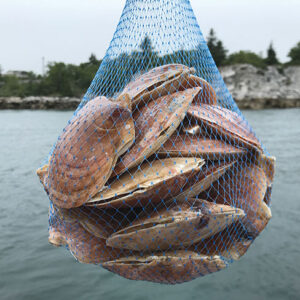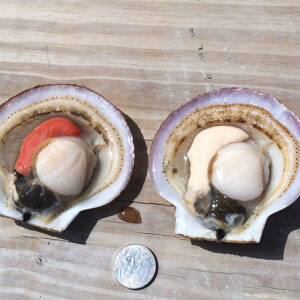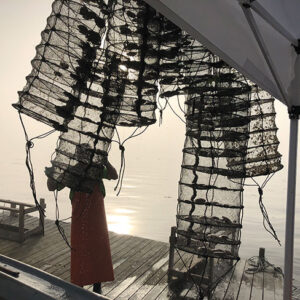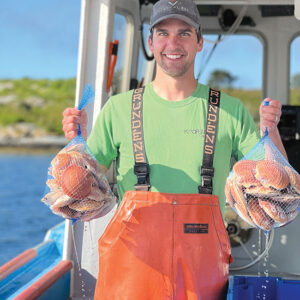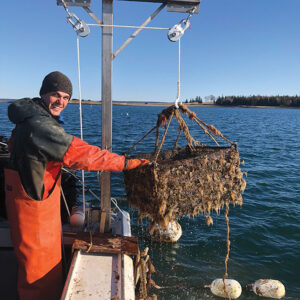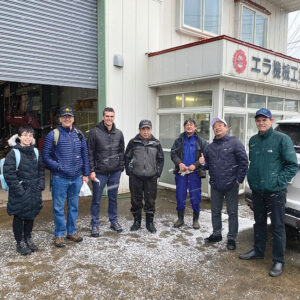
More than a job: Can sea scallop help preserve the working waterfront?
March 29, 2023
By Lynn Fantom
As climate threatens Maine’s lobster industry, will sea scallop aquaculture help preserve the working waterfront?
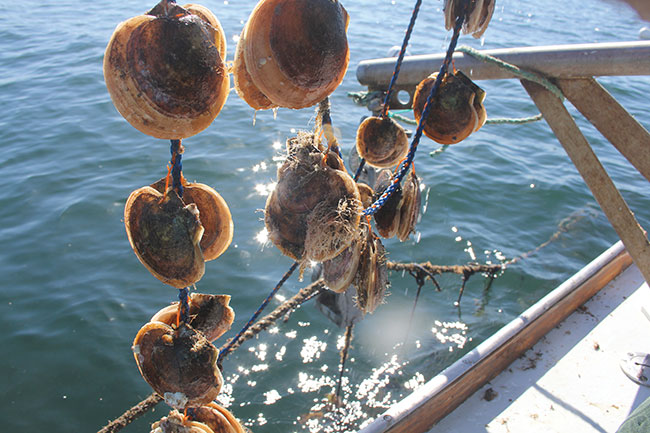 Farmers drill a tiny hole in each scallop and attach it to a dropline to grow out in deep, cold water—ideally 10–15 C (50–59 F). Sea temperature is the most significant predictor of growth.
Photo: Coastal Enterprises Inc.
Farmers drill a tiny hole in each scallop and attach it to a dropline to grow out in deep, cold water—ideally 10–15 C (50–59 F). Sea temperature is the most significant predictor of growth.
Photo: Coastal Enterprises Inc. At the beginning of Andrew Peters’ first Econ 101 class at elite Middlebury College in 2005, the professor asked students to introduce themselves and share their career interests. “Law,” “technology,” and “investment banking” echoed among the 80 or so in the lecture hall, with one stand-out. “Lobsterman,” Peters stated.
It was a goal the Albany native had fixed on as a 12-year-old during a family sailing trip and, although he eventually worked for several years as a sternman, the profession proved out of reach because of the limited number of commercial lobstering licenses in Maine. A job at Google would have been easier to nab.
But now Andrew Peters is making his way on the water in a role that defines entrepreneurship. He is one of just a handful of ocean farmers growing sea scallops in Maine. If his econ professor were to illustrate his vocation as a Venn diagram, it would lie at the intersection of passion, hard work, and innovation.
Peters’ foray into sea scallop aquaculture comes as the future of Maine’s $730 million lobster industry faces serious challenges, including northward lobster migrations due to warming waters and federal regulations of gear related to right whale entanglements. But at the same time, fisheries are diversifying with bivalve and kelp farming, and the economy has been invigorated with an influx of Millennials, including remote workers who permanently fled cities to Maine’s great outdoors and more affordable real estate during the pandemic. Despite wariness about the lobster fishery, there’s a sparkle in Maine’s Blue Economy.
Risks and rewards
Entrepreneurs are driven by a vision. “Yeah, I guess I’m a dreamer, too,” Peters said, whose degree is in geology. But, by definition, entrepreneurs also shoulder risk. And there’s a lot of risk in growing sea scallops. No one has done it yet as a sustainable enterprise in Maine—or anywhere in the U.S. Getting a lease is time-consuming and arduous. Start-up costs are steep and, even with funding, delivery of some equipment can approach a year. Seed is not available commercially (see sidebar) and takes about 9 months to collect and cultivate in the wild. Plus, the animal itself Placopecten magellanicus is fragile and needs at least two years before it’s marketable.
It’s clearly not a get-rich-quick idea. “The time scale is just extraordinary,” Peters said.
On the other hand, “the market is seemingly endless,” he added. The key evidence is the wild scallop fishery. According to NOAA Fisheries, Atlantic sea scallop catch in the New England – Mid-Atlantic regions totaled $670 million in 2021. (That compares to the regional American lobster landings of $925 million, 80 percent of which occurred in Maine.) And to satisfy Americans’ appetite for scallops, the country imports $300 to $350 million more.
The role of aquaculture to supplement the wild harvest has emerged as an opportunity that could be a boon both to the region’s economy and individual livelihoods. And this species—in contrast to, say, kelp, which requires some consumer education—is one Americans already love and pay more for at the fish counter.
Two decades of research
In 1999, an eclectic group—including a scallop processor, writer, professor, community development specialist, and scallop fisherman as well as farmer—formed a delegation to visit Aomori, Japan, the second largest producer of scallops in Japan and the national birthplace of scallop culture. The goal was to see if experts there might help solve problems plaguing Maine’s wild scallop industry, which was “in serious trouble,” the group reported.
During the following decade, efforts in Maine focused on the collection of seed (spat) as “an enhancement technique for wild fishing,” said Hugh Cowperthwaite, senior program director of fisheries and aquaculture at Coastal Enterprises Inc. (CEI). Then, in 2010, another delegation visited the Japanese prefecture, which had a formal sister-state relationship with Maine. It was at that point that “the light bulb went on,” said Cowperthwaite, and attention turned to, “Why aren’t we doing this? We can farm this species and truly try to ramp it up.”
That paved the way for a series of trials exploring equipment (like lantern and pearl nets) and grow-out methods (using long lines in deeper water). The ear-hanging technique, which required drilling a tiny hole in each scallop individually and attaching it with a plastic pin to a dropline, became the symbol of the painstaking farming process.
But Maine approached the challenge as a group project. Successful scallop farms were already operating in Argentina, Peru, France, and, of course, Japan, where there were 1,900 of them. “How is scallop farming done in other parts of the world and how do we adapt it for Maine?” became the mantra of nonprofits, university departments, federal agencies, and aquaculture practitioners up and down the coast.
And now?
This massive push produced many studies on optimal environment and culture practices so that evidence-based production guidelines (such as Struan Coleman’s 2022 article in “Aquaculture”) exist today. Plus, Aomori relationships opened up the opportunity for nonprofits and federally funded programs to purchase specialized equipment. For example, from Japanese manufacturer Mutsu Kaden Tokki Co., CEI acquired an ear-hanging drilling machine, scallop grader, and washing system, which have made their way among trial farming sites statewide.
Among those spearheading automation was family-owned Hollander and de Koning Mussel Farms near Mount Desert Island, where Alex de Koning, who earned an engineering degree from University of Maine, was pursuing a special interest in scallop aquaculture that dated back to a 2009 high school project. With a grant from NOAA Fisheries, the farm purchased an all-in-one drilling and pinning machine from another manufacturer, HAMADE. It triples the production that can be accomplished by hand. This foray with a different manufacturer suggests a new kind of acceleration in the industry as more entrepreneurs explore new relationships.
Farms are now selling to a wholesaler and directly to restaurants. “The whole sector is evolving, but markets are definitely an evolving piece as well,” said Dana Morse of Maine Sea Grant at the University of Maine, whose experience with scallops dates back to the 1999 delegation to Aomori. The traditional market has been for the adductor muscles or meats. But there’s a lot of buzz now around selling the whole animal live, which yields a higher price but also requires costly biotoxin testing. “It remains to be seen, which is going to be more profitable,” he added.
On the farm
Andrew Peters’ farm, called Vertical Bay, is about a mile and a half from the mainland. A static submerged long line, moored on both ends to the bottom about 45 feet below, is the main infrastructure. From that 800-foot horizontal line, Peters hangs lantern nets and dropper lines into the cold, nutrient-rich water of Eastern Penobscot Bay. He’ll be able to expand beyond this 3.91-acre plot with more lines when his application for a bigger lease gets the greenlight from the Maine Department of Marine Resources.
When he is working—at certain times, with a helper or two—the only signs of the farm’s existence are yellow buoys, perhaps a high flyer, and his boat. The view of a scallop farm fits right into what wealthy coastal property owners think of as iconic scenery.
Peters has had gear in the water since 2018, when a grant of $12,339 from Maine Technology Institute helped him “get started.” He went from 200 scallops to 40,000 the next year. “It was important to go for it and not hobby along. Any business like this needs to find that sweet spot where there’s enough volume to make money but the work is also manageable,” he said. Working with the University of Maine has produced a viable “bioeconomic model.”
The relationship between how much space scallops need to thrive and the costs to provide that in nets is another one of the challenges in scallop farming. “Scallops do not like to be crowded,” said Sea Grant’s Morse.
They don’t clamp their shell parts tight like other bivalves and can actually “knife” others if too close.
This means that managing density within the nets as the scallops grow is a key husbandry task. It also means a much greater budget for growing gear to accommodate the same amount of marketable product.
Most days on the water now for Peters are a solo enterprise—collecting spat in bags in September and safeguarding its growth in the ocean, transferring the baby scallops to nets in the spring, managing density and cleaning nets in summer. But, that solitary work is only part of the picture. Peters said, “My biggest surprise was how collaborative the industry is. There’s a lot of support, informational funding, just motivation through all these entities, whether it’s the university, CEI, private people.”
Still, the challenge remains. A scallop farm needs scale to be a viable business. “Growing and selling scallops on a small scale is pretty straightforward; It is how you scale up to a profitable enterprise that can sustain itself and its employees,” said Peters. “It’s more capital intensive than I originally thought. I wouldn’t wave the flag and say we’re there yet. But potentially we are the proof of concept for a future industry. And that’s really exciting.”
